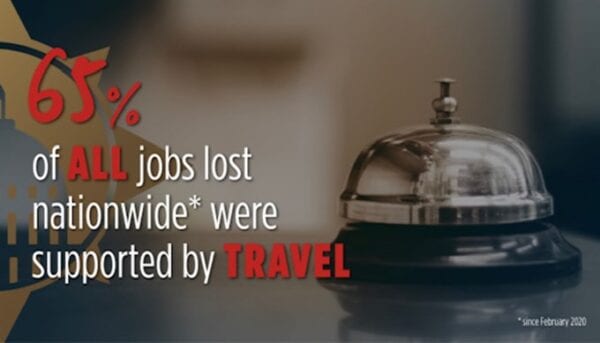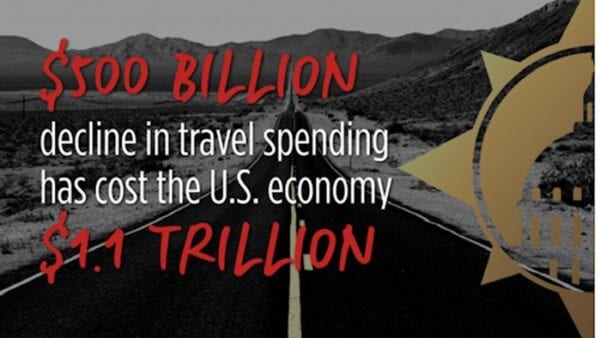First the unsettling news—news that most of us are all too familiar with. The 2020 lockdowns devastated the travel, hospitality, and event industry in 2020. To drive that point home, here are some startling statistics:
- The number of exhibitions in the U.S. in 2020 decreased by 78.8 percent, (compared with 2019, according to
 a recent CEIR report).
a recent CEIR report). - 6 million travel-related jobs were lost in 2020 due to global lockdowns (according to the U. S. Travel Association).
- The U.S. travel industry shrunk by 42 percent in 2020 (source: USTA).
- 8 million jobs were lost in the meetings and events industry in 2020 (source: Go Live Together).
- Worldwide, the travel industry lost nearly $4.5 trillion due to the 2020 lockdowns, according to a recently released Economic Impact Report from the World Travel & Tourism Council.

So, what’s the good news?
Tradeshows feed the travel and hospitality industry. As tradeshows return, travel will increase (we have already seen this on a local and regional level). As travel increases, more tradeshows will appear. It’s a symbiotic relationship. And there are at least five reasons to be optimistic.
First: Live, face-to-face events are happening! Last year, the vast majority of U.S. tradeshows were in Florida (there have been approximately 60 events at the OCCC since the start of the lockdown). This year, multiple shows have been popping up in states throughout the South, and are starting to appear in other sections of the country as well.
Tradeshows are not mass gatherings. Safe, live events are both possible and desired—craved by exhibitors, attendees, businesses, associations and workers. States are finally changing occupancy restrictions, and more convention centers are opening their doors and hosting shows.
 Second: Travel will put people back to work; travel will increase numbers at tradeshows. Millions of people in the U.S. are traveling by air these days. On 19 of the first 24 days in March, more than a million people a day passed through airport TSA checkpoints; at least one million flew on 14 consecutive days, from March 11-24. A record 1,545,115 passengers flew on March 21. More than 25 million people in the first 24 days of March traveled by air! There likely will be an uptick in the number of COVID cases, but increased travel is here to stay, especially as the weather gets warmer. Travel will put people back to work; travel will increase numbers at tradeshows.
Second: Travel will put people back to work; travel will increase numbers at tradeshows. Millions of people in the U.S. are traveling by air these days. On 19 of the first 24 days in March, more than a million people a day passed through airport TSA checkpoints; at least one million flew on 14 consecutive days, from March 11-24. A record 1,545,115 passengers flew on March 21. More than 25 million people in the first 24 days of March traveled by air! There likely will be an uptick in the number of COVID cases, but increased travel is here to stay, especially as the weather gets warmer. Travel will put people back to work; travel will increase numbers at tradeshows.
Third: The data is encouraging. Freeman event research has positive news for the industry—they surveyed more than a million attendees and organizers with 78 percent of those responding said they would be confident returning to events during the third quarter; 95 percent said they would be by winter. Other results from the report are quoted below:
- “Travel and budget restrictions are lifting: 68 percent of attendees and 71 percent of exhibitors expect to have no corporate restrictions by Q3 2021”
- “80 percent of exhibitors expect to attend in–person events in fall 2021”
These are awesome numbers! People want to attend shows, and companies will be allowing it.
Fourth: Vaccines are a shot in the arm. “Vaccination propels confidence: 86 percent of attendees who are vaccinated or plan to be are more confident in returning to in-person events,” according to Freeman event research.
If vaccinations continue at the current rate of 2 million shots per day, herd immunity could be reached sometime this summer. As more vaccinations occur, more people will likely be more comfortable and willing to travel to tradeshows.
Fifth: Advocacy works. The U.S. Travel Association, Go Live Together, Exhibitions Mean Business, the Exhibitions and Conferences Alliance—all of these associations are, and have been, speaking with members of Congress. Through advocacy, we are becoming less of an invisible industry.
 On March 17, the U.S. Travel Association hosted an event in Washington D.C. called Destination Capitol Hill. The event was designed to educate public officials and policymakers on the importance of travel (and travel-related industries) to the overall health of the U.S. economy.
On March 17, the U.S. Travel Association hosted an event in Washington D.C. called Destination Capitol Hill. The event was designed to educate public officials and policymakers on the importance of travel (and travel-related industries) to the overall health of the U.S. economy.
The Association, with 26 other organizations, contacted the White House asking to develop “a risk-based, data-driven roadmap to rescind inbound travel restrictions.” They are asking for this plan to be announced by May 1. Proof of vaccination, so-called “vaccination passport apps” may be discussed, although this effort may also create controversy regarding privacy concerns.
What can individuals and businesses do?
 Get involved. Talk with co-workers. Speak with other business owners. Join industry associations. Communicate with local, state and federal officials.
Get involved. Talk with co-workers. Speak with other business owners. Join industry associations. Communicate with local, state and federal officials.
People miss face-to-face events. Tradeshows are occurring. Travel is opening up. Vaccinations are increasing. People are becoming more comfortable with the idea of attending shows. More tradeshows will happen in the second quarter this year, than there were in the first. And that trend will increase into the third quarter. There is such a demand and backlog of shows that between August and December, there will be a greater number of shows than typical for that period (although the number of exhibitors and attendees will still be lower than in 2019). Tradeshows will happen, and they will bring local people back to work. Airlines, hotels, restaurants, bars and nightclubs, cab and Uber drivers, convention workers—all will benefit, along with local tax revenues.
Tradeshows fuel the economy and drive business. It’s time to get this engine running again.
Bob McGlincy is director, business management at Willwork Global Event Services. Willwork creates engaging, energized, and exceptional event experiences. He can be contacted at Bob.McGlincy@willwork.com































